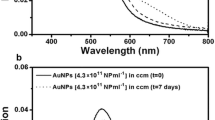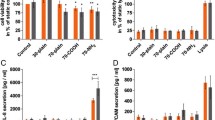Abstract
The use of nanoparticles is becoming increasingly common in industry and everyday objects. Thus, extensive risk management concerning the potential health risk of nanoparticles is important. Currently, in vitro nanoparticle testing is mainly performed under static culture conditions without any shear stress. However, shear stress is an important biomechanical parameter. Therefore, in this study, a defined physiological flow to different mammalian cell lines such as A549 cells and NIH-3T3 cells has been applied. The effects of zinc oxide and titanium dioxide nanoparticles (TiO2-NP), respectively, were investigated under both static and dynamic conditions. Cell viability, cell morphology, and adhesion were proven and compared to the static cell culture. Flow exposure had an impact on the cellular morphology of the cells. NIH-3T3 cells were elongated in the direction of flow and A549 cells exhibited vesicles inside the cells. Zinc oxide nanoparticles reduced the cell viability in the static and in the dynamic culture; however, the dynamic cultures were more sensitive. In the static culture and in the dynamic culture, TiO2-NP did not affect cell viability. In conclusion, dynamic culture conditions are important for further in vitro investigations and provide more relevant results than static culture conditions.




Similar content being viewed by others
References
Bloh JZ, Dillert R, Bahnemann DW (2012) Transition metal-modified zinc oxides for UV and visible light photocatalysis. Environ Sci Pollut Res Int 19:3688–3695. doi:10.1007/s11356-012-0932-y
Bloh JZ, Dillert R, Bahnemann DW (2014) Ruthenium-modified zinc oxide, a highly active vis-photocatalyst: the nature and reactivity of photoactive centres. Phys Chem Chem Phys 16:5833–5845. doi:10.1039/C3cp55136a
Conant C, Nevill JT, Ionescu-Zanetti C (2013) Live cell analysis under shear flow micofluidic cell culture systems
da Rocha EL, Porto LM, Rambo CR (2014) Nanotechnology meets 3D in vitro models: tissue engineered tumors and cancer therapies Materials science & engineering C. Mater Biol Appl 34:270–279. doi:10.1016/j.msec.2013.09.019
Dechsakulthorn F, Hayes A, Bakand S, Joeng L, Winder C (2007) In vitro cytotoxicity assessment of selected nanoparticles using human skin fiborblasts. AATEX 14:397–400
Demir E et al (2014) Genotoxic and cell-transforming effects of titanium dioxide nanoparticles. Environ Res 136C:300–308. doi:10.1016/j.envres.2014.10.032
Di Virgilio AL, Reigosa M, Arnal PM, Lorenzo Fernandez, de Mele M (2010) Comparative study of the cytotoxic and genotoxic effects of titanium oxide and aluminium oxide nanoparticles in Chinese hamster ovary (CHO-K1) cells. J Hazard Mater 177:711–718. doi:10.1016/j.jhazmat.2009.12.089
Ditto AJ, Shah KN, Robishaw NK, Panzner MJ, Youngs WJ, Yun YH (2012) The Interactions between l-tyrosine based nanoparticles decorated with folic acid and cervical cancer cells under physiological flow. Mol Pharm 9:3089–3098. doi:10.1021/mp300221f
Fede C et al (2015) Evaluation of gold nanoparticles toxicity towards human endothelial cells under static and flow conditions. Microvasc Res 97:147–155. doi:10.1016/j.mvr.2014.10.010
Fernández D, García-Gómez C, Babín M (2013) In vitro evaluation of cellular responses induced by ZnO nanoparticles, zinc ions and bulk ZnO in fish cells. Sci Total Environ 452–453:262–274. doi:10.1016/j.scitotenv.2013.02.079
Freese C, Schreiner D, Anspach L, Bantz C, Maskos M, Unger RE, Kirkpatrick C (2014) In vitro investigation of silica nanoparticle uptake into human endothelial cells under physiological cyclic stretch. Part Fibre Toxicol 11:1. doi:10.1186/s12989-014-0068-y
Fukui H et al (2012) Association of zinc ion release and oxidative stress induced by intratracheal instillation of ZnO nanoparticles to rat lung. Chem Biol Interact 198:29–37. doi:10.1016/j.cbi.2012.04.007
Fulda S, Gorman AM, Hori O, Samali A (2010) Cellular stress responses: cell survival and cell death International journal of cell biology 2010:214074. doi:10.1155/2010/214074
Gamerdinger K, Wernet F, Smudde E, Schneider M, Guttmann J, Schumann S (2014) Mechanical load and mechanical integrity of lung cells: experimental mechanostimulation of epithelial cell- and fibroblast-monolayers. J Mech Behav Biomed 40:201–209. doi:10.1016/j.jmbbm.2014.08.013
Gao D, Liu HX, Jiang YY, Lin JM (2012) Recent developments in microfluidic devices for in vitro cell culture for cell-biology research. Trac-Trend Anal Chem 35:150–164. doi:10.1016/j.trac.2012.02.008
Hanley C, Thurber A, Hanna C, Punnoose A, Zhang J, Wingett D (2009) The influences of cell type and ZnO nanoparticle size on immune cell cytotoxicity and cytokine induction. Nanoscale Res Lett 4:1409–1420
Heng B et al (2011) Evaluation of the cytotoxic and inflammatory potential of differentially shaped zinc oxide nanoparticles. Arch Toxicol 85:1517–1528. doi:10.1007/s00204-011-0722-1
Hsiao IL, Huang YJ (2011) Titanium oxide shell coatings decrease the cytotoxicity of ZnO nanoparticles. Chem Res Toxicol 24:303–313. doi:10.1021/tx1001892
Kao YY, Chen YC, Cheng TJ, Chiung YM, Liu PS (2012) Zinc oxide nanoparticles interfere with zinc ion homeostasis to cause cytotoxicity. Toxicol Sci 125:462–472. doi:10.1093/toxsci/kfr319
Kim J, Hayward RC (2012) Mimicking dynamic in vivo environments with stimuli-responsive materials for cell culture. Trends Biotechnol 30:426–439. doi:10.1016/j.tibtech.2012.04.003
Kusunose J, Zhang H, Gagnon MK, Pan T, Simon SI, Ferrara KW (2013) Microfluidic system for facilitated quantification of nanoparticle accumulation to cells under laminar flow. Ann Biomed Eng 41:89–99. doi:10.1007/s10439-012-0634-0
Li Z, Cui Z (2014) Three-dimensional perfused cell culture. Biotechnol Adv 32:243–254. doi:10.1016/j.biotechadv.2013.10.006
Li J, Guo D, Wang X, Wang H, Jiang H, Chen B (2010) The photodynamic effect of different size ZnO nanoparticles on cancer cell proliferation in vitro. Nanoscale Res Lett 5:1063–1071. doi:10.1007/s11671-010-9603-4
Li S, Song W, Gao M (2013) Single and combined cytotoxicity research of propiconazole and nano-zinc oxide on the NIH/3T3. Cell. doi:10.1016/j.proenv.2013.04.014
Lin W, Xu Y, Huang C-C, Ma Y, Shannon K, Chen D-R, Huang Y-W (2009) Toxicity of nano- and micro-sized ZnO particles in human lung epithelial cells. J Nanopart Res 11:25–39. doi:10.1007/s11051-008-9419-7
Mahto SK, Yoon TH, Rhee SW (2010) A new perspective on in vitro assessment method for evaluating quantum dot toxicity by using microfluidics technology. Biomicrofluidics. doi:10.1063/1.3486610
Male KB, Hamzeh M, Montes J, Leung AC, Luong JH (2013) Monitoring of potential cytotoxic and inhibitory effects of titanium dioxide using on-line and non-invasive cell-based impedance spectroscopy. Anal Chim Acta 777:78–85. doi:10.1016/j.aca.2013.03.044
Park J, Fan Z, Deng CX (2011) Effects of shear stress cultivation on cell membrane disruption and intracellular calcium concentration in sonoporation of endothelial cells. J Biomech 44:164–169. doi:10.1016/j.jbiomech.2010.09.003
Romanello MB, Fidalgo de Cortalezzi MM (2013) An experimental study on the aggregation of TiO2 nanoparticles under environmentally relevant conditions. Water Res 47:3887–3898. doi:10.1016/j.watres.2012.11.061
Sambale F et al (2015a) Three dimensional spheroid cell culture for nanoparticle safety testing. J Biotechnol. doi:10.1016/j.jbiotec.2015.01.001
Sambale F, Stahl F, Rüdinger F, Kasper C, Bahnemann DTS (2015) Advanced cellular screening system for nanoparticle safety testing submitted to environmental science: nano
Seiffert JM, Baradez MO, Nischwitz V, Lekishvili T, Goenaga-Infante H, Marshall D (2012) Dynamic monitoring of metal oxide nanoparticle toxicity by label free impedance sensing. Chem Res Toxicol 25:140–152. doi:10.1021/tx200355m
Soenen SJ, Parak WJ, Rejman J, Manshian B (2015) (Intra)Cellular stability of inorganic nanoparticles: effects on cytotoxicity. Part Funct Biomed Appl Chem Rev 115:2109–2135. doi:10.1021/cr400714j
Steinritz D et al (2013) Use of the Cultex(R) radial flow system as an in vitro exposure method to assess acute pulmonary toxicity of fine dusts and nanoparticles with special focus on the intra- and inter-laboratory reproducibility. Chem Biol Interact 206:479–490. doi:10.1016/j.cbi.2013.05.001
Tang Z, Akiyama Y, Itoga K, Kobayashi J, Yamato M, Okano T (2012) Shear stress-dependent cell detachment from temperature-responsive cell culture surfaces in a microfluidic device. Biomaterials 33:7405–7411. doi:10.1016/j.biomaterials.2012.06.077
Thomas A, Tan J, Liu Y (2014) Characterization of nanoparticle delivery in microcirculation using a microfluidic device. Microvasc Res 94:17–27. doi:10.1016/j.mvr.2014.04.008
Tsui JH, Lee W, Pun SH, Kim J, Kim DH (2013) Microfluidics-assisted in vitro drug screening and carrier production. Adv Drug Deliv Rev 65:1575–1588. doi:10.1016/j.addr.2013.07.004
Ucciferri N et al (2014) In vitro toxicological screening of nanoparticles on primary human endothelial cells and the role of flow in modulating cell response. Nanotoxicology 8:697–708. doi:10.3109/17435390.2013.831500
Valencia PM, Farokhzad OC, Karnik R, Langer R (2012) Microfluidic technologies for accelerating the clinical translation of nanoparticles. Nat Nanotechnol 7:623–629. doi:10.1038/nnano.2012.168
Wagner S, Münzer S, Behrens P, Scheper T, Bahnemann D, Kasper C (2008) Cytotoxicity of titanium and silicon dioxide nanoparticles. J Phys. doi:10.1088/1742-6596/170/1/012022
Xia L et al (2009) Laminar-flow immediate-overlay hepatocyte sandwich perfusion system for drug hepatotoxicity testing. Biomaterials 30:5927–5936. doi:10.1016/j.biomaterials.2009.07.022
Ying B et al (2006) Mechanical strain-induced c-fos expression in pulmonary epithelial cell line A549. Biochem Biophys Res Commun 347:369–372. doi:10.1016/j.bbrc.2006.06.105
Zhang H et al (2012) Use of metal oxide nanoparticle band gap to develop a predictive paradigm for oxidative stress and acute pulmonary inflammation. ACS nano 6:4349–4368. doi:10.1021/nn3010087
Zhu X, Hondroulis E, Liu W, Li CZ (2013) Biosensing approaches for rapid genotoxicity and cytotoxicity assays upon nanomaterial exposure. Small 9:1821–1830. doi:10.1002/smll.201201593
Acknowledgments
This work was supported by the European Regional Development Fund (EFRE Project “Nanokomp”, Grant No.: 60421066). Detlef Bahnemann kindly acknowledges support by the project “Establishment of the Laboratory of Photoactive Nanocomposites Materials” (No. 14.750.31.0016) supported by a Grant from the Government of the Russian Federation.
Author information
Authors and Affiliations
Corresponding author
Ethics declarations
Conflict of interest
The authors declare that they have no conflict of interest.
Rights and permissions
About this article
Cite this article
Sambale, F., Stahl, F., Bahnemann, D. et al. In vitro toxicological nanoparticle studies under flow exposure. J Nanopart Res 17, 298 (2015). https://doi.org/10.1007/s11051-015-3106-2
Received:
Accepted:
Published:
DOI: https://doi.org/10.1007/s11051-015-3106-2




